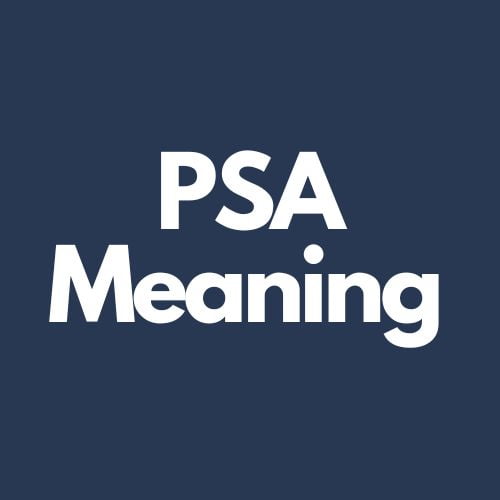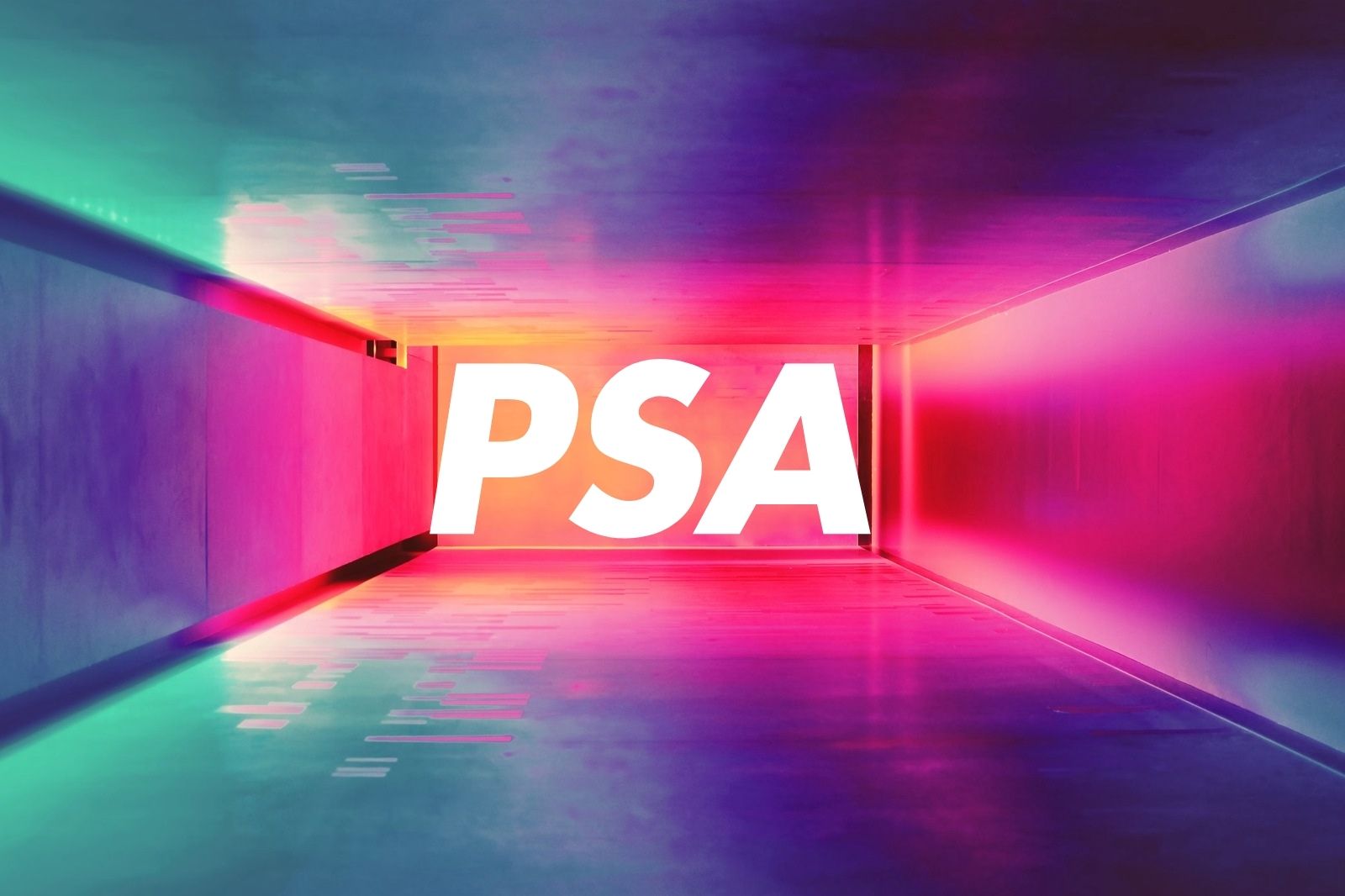Hey there, curious mind! Ever stumbled upon the term "PSA" while texting or scrolling through social media and wondered what it actually means? You're not alone! PSA has become a widely used acronym in modern communication, but its meaning might not be immediately obvious to everyone. In this article, we'll break it down for you and help you understand why PSA is more than just three random letters. So, buckle up and let’s dive into the world of PSA!
Whether you're a tech-savvy millennial or someone who’s just getting the hang of modern lingo, understanding acronyms like PSA can make your digital communication smoother and more effective. Don’t worry, we’ve got you covered with everything you need to know about PSA in text, including its origins, common uses, and how to use it like a pro.
In today’s fast-paced world, communication is all about brevity and clarity. Acronyms like PSA play a crucial role in keeping conversations concise while conveying important information. So, let’s explore what PSA means, why it’s important, and how it fits into our everyday digital lives.
Read also:Who Won Shakiras Car The Ultimate Answer Yoursquove Been Searching For
Table of Contents
- The Origin of PSA
- What Does PSA Mean in Text?
- Common Uses of PSA in Everyday Life
- How to Use PSA Effectively
- Common Misconceptions About PSA
- PSA vs Other Acronyms: What’s the Difference?
- Using PSA in Professional Settings
- PSA Usage Statistics and Trends
- Pro Tips for Mastering PSA
- Wrapping It Up: Why PSA Matters
The Origin of PSA: Where Did It All Begin?
Before we dive into the nitty-gritty of what PSA means in text, let’s take a quick trip down memory lane. PSA, or Public Service Announcement, has been around for decades, long before the rise of texting and social media. Originally, PSAs were messages broadcasted on TV or radio to inform the public about important issues like health, safety, and community involvement.
Fast forward to today, and PSA has made its way into the digital world. It’s no longer just about TV ads or radio spots; it’s now a go-to term for sharing important information quickly and efficiently in text form. Whether it’s a group chat or a social media post, PSA has become a staple in modern communication.
How PSA Evolved Over Time
Back in the day, PSAs were all about public broadcasting. Think about those iconic anti-smoking campaigns or road safety ads. But as technology advanced, so did the way we communicate. Now, PSA is just as likely to appear in a text message or a tweet as it is on TV. This evolution has made PSA more accessible and relatable to a wider audience.
What Does PSA Mean in Text?
In the world of texting and social media, PSA stands for Public Service Announcement. It’s a way to share important information or reminders with others, often in a casual or informal setting. Think of it as a digital version of those old-school public announcements, but with a modern twist.
For example, if you’re in a group chat and someone says, “PSA: Don’t forget to bring sunscreen to the beach tomorrow,” they’re using PSA to remind everyone about something important. It’s a quick and effective way to get the message across without sounding too formal.
Breaking Down the Meaning
Let’s break it down even further. PSA is made up of three simple words:
Read also:Unveiling The Secrets Of Dti Teddy Bear Code Your Ultimate Guide
- Public: It’s meant for everyone in the group or community.
- Service: It’s about providing a service or helping others.
- Announcement: It’s a message or reminder being shared.
So, when you put it all together, PSA is all about sharing information that benefits the public or a specific group. It’s a win-win for everyone involved!
Common Uses of PSA in Everyday Life
Now that we know what PSA means, let’s talk about how it’s used in everyday life. Whether you’re texting your friends, posting on social media, or even sending an email, PSA can come in handy in a variety of situations.
Here are some common scenarios where you might use PSA:
- Reminding your friends about an upcoming event.
- Sharing important news or updates with your team at work.
- Alerting your community about a safety issue or emergency.
- Spreading awareness about a cause or campaign.
PSA is versatile and can be used in both casual and formal settings, making it a valuable tool in your communication arsenal.
Examples of PSA in Action
Let’s look at a few real-life examples of PSA in action:
- “PSA: The office will be closed on Friday due to the holiday.”
- “PSA: Don’t forget to vote in the upcoming election!”
- “PSA: There’s a thunderstorm warning in effect tonight.”
See how easy it is to incorporate PSA into your daily conversations? It’s a simple yet powerful way to get your point across.
How to Use PSA Effectively
Using PSA effectively is all about timing and context. You want to make sure your message is clear, concise, and relevant to your audience. Here are a few tips to help you master the art of PSA:
- Keep it short and sweet: PSA works best when it’s brief and to the point. No one wants to read a novel in a group chat!
- Be respectful: Remember, PSA is about helping others, so be mindful of how you phrase your message.
- Use it sparingly: Too many PSAs can become overwhelming, so save them for truly important information.
By following these tips, you can ensure that your PSAs are well-received and effective in getting your message across.
Best Practices for PSA
Here are a few best practices to keep in mind when using PSA:
- Always double-check your facts before sharing information.
- Use a friendly tone to avoid coming across as too formal or bossy.
- Consider your audience and tailor your message accordingly.
Remember, the goal of PSA is to inform and assist, not to confuse or overwhelm.
Common Misconceptions About PSA
Despite its popularity, there are still some misconceptions about PSA that we need to clear up. Here are a few common ones:
- PSA is only for serious topics: While PSA is often used for important or urgent matters, it can also be used for lighthearted reminders or fun facts.
- PSA is outdated: On the contrary, PSA is more relevant than ever in our digital age. It’s a quick and effective way to share information with others.
- PSA is only for public broadcasting: Nope! PSA can be used in any setting, from personal chats to professional emails.
By understanding these misconceptions, you can use PSA more effectively and avoid any unnecessary confusion.
Debunking the Myths
Let’s take a closer look at one of the most common myths: the idea that PSA is only for serious topics. While it’s true that PSA is often used to share important information, it doesn’t have to be all doom and gloom. For example, you could use PSA to remind your friends about a fun event or to share a cool new app you discovered. The possibilities are endless!
PSA vs Other Acronyms: What’s the Difference?
With so many acronyms floating around in the digital world, it’s easy to get confused. So, how does PSA differ from other popular acronyms like FYI or IMO? Let’s break it down:
- PSA vs FYI: While both acronyms are used to share information, PSA is more focused on public announcements, whereas FYI is more personal or informal.
- PSA vs IMO: IMO is used to express personal opinions, while PSA is all about sharing factual information.
Understanding the differences between these acronyms can help you choose the right one for your message.
Choosing the Right Acronym
When deciding whether to use PSA or another acronym, consider the context and purpose of your message. If you’re sharing important information with a group, PSA is usually the way to go. But if you’re just sharing a personal thought or opinion, FYI or IMO might be more appropriate.
Using PSA in Professional Settings
PSA isn’t just for casual conversations; it can also be a valuable tool in professional settings. Whether you’re working in a corporate office or running your own business, PSA can help you communicate important information to your team or clients.
For example, you could use PSA to:
- Announce a new company policy or procedure.
- Remind employees about an upcoming deadline or meeting.
- Share updates about a project or initiative.
By incorporating PSA into your professional communication, you can ensure that everyone stays informed and on the same page.
Professional PSA Examples
Here are a few examples of PSA in a professional setting:
- “PSA: The new expense report policy goes into effect next week.”
- “PSA: The quarterly meeting has been rescheduled to Friday at 10 AM.”
- “PSA: Please remember to submit your timesheets by the end of the day.”
As you can see, PSA is a versatile tool that can be adapted to fit any professional situation.
PSA Usage Statistics and Trends
So, how popular is PSA in today’s digital world? According to recent studies, the use of acronyms like PSA has been on the rise, especially among younger generations. In fact, a survey conducted by a leading tech company found that over 70% of respondents use acronyms like PSA in their daily communication.
These statistics highlight the growing importance of acronyms in modern communication. As more people turn to digital platforms for their daily interactions, the need for quick and efficient ways to share information becomes even more critical.
Why PSA is Here to Stay
With its versatility and widespread usage, PSA is likely to remain a staple in digital communication for years to come. Its ability to convey important information in a concise and effective manner makes it an invaluable tool for both personal and professional use.
Pro Tips for Mastering PSA
Want to take your PSA game to the next level? Here are a few pro tips to help you master the art of PSA:
- Always lead with the most important information.
- Use emojis or visuals to make your message more engaging.
- Test your message on a small group before sending it to a larger audience.
By following these tips, you can ensure that your PSAs are not only effective but also engaging and memorable.
Final Thoughts on PSA Mastery
Remember, the key to mastering PSA is to keep it simple, relevant, and respectful. Whether you’re sharing a reminder with your friends or informing your team about a new project, PSA can help you get your message across with ease.
Wrapping It Up: Why PSA Matters
So, there you have it – everything you need to know about PSA in text. From its origins as a public service announcement to its current role in modern communication, PSA has proven to be a valuable tool for sharing important information quickly and effectively.
As we’ve explored in this article, PSA can be used in a variety of


